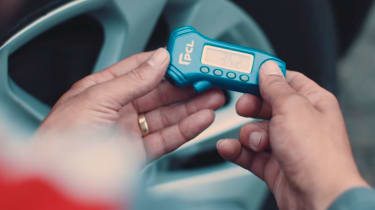How to look after your tyres (sponsored)
Checking your tyres for damage and ensuring your tread depth is sufficient is easy – we show you how.
Checking your tyres is one of the easiest things you can do. Whether it’s ensuring tyre pressures are correct, looking for damage or making sure your tyres have got enough tread, it’s a straightforward job you can do yourself.
Tyre pressures
Having the wrong tyre pressures can increase fuel consumption and reduce safety, so it’s essential you get them right. The correct tyre pressures will be displayed inyour car, usually on a sticker in one of the door jambs or on the back of your fuel filler flap. Alternatively check your car’s handbook.
Remove the dust cap on each tyre in turn and use a tyre pressure monitor to measure the pressure. You’ll need to press the tyre pressure monitor onto the tyre’s valve in accordance with the monitor’s instructions. If they’re underinflated, pump up the tyre. If they’re overinflated let out some air by pressing the valve with your fingernail.

Many foot pumps and electric tyre compressors, including those you’ll find in many petrol stations, feature a tyre pressure gauge so you can check and inflate at the same time.
It’s essential your tyres are inflated correctly – too much or too little air, and your car’s ability to grip the road will be seriously compromised. Plus you could increase tyre wear and fuel consumption.
Checking tyre condition and tread depth
Checking tyres for damage is fairly straightforward. If there are any cuts, cracks or bulges in your tyre, it’s time you replaced them.
Examining your tyres’ tread depth is a little more involved, but absolutely essential. The rules on tread depth are clear – you must have at least 1.6mm of tread over the central threequarters of your tyre around the entire circumference.
Any less and you’ll be putting yourself, your passengers and other road users at risk. If you’re caught driving with insufficient tread depth, you could face a hefty fine. To check your tyre’s tread depth you can use a tread depth gauge, which you can buy from most car spares shops. The gauge has a protruding rod on the end, which you’ll need to push gently into your tyres’ tread. The other end of the gauge has a measure which tells you how much tread you have.
The alternative is to use a 20p coin. The outer rim of the coin is approximately 1.6mm, so if you can see any of the rim, you’ll need a new tyre.

While 1.6mm is the minimum legal requirement, you should consider replacing your tyres when the tread passes 3mm as grip deteriorates quickly after this point. It’s a good idea to replace the tyre with one that’s recommended and fitted to the car originally by the manufacturer, so speak to your local Nissan dealer. You should also check your spare tyre’s condition too. Don’t have one? Your dealer can supply you with one.
Checking your tyres should be safety check you do regularly, but for ultimate peace of mind, Nissan’s Vehicle Health Check will analyse your car to alert you to any potential faults, such as tyre wear or damage.
For more information, the very best service and peace of mind, visit your local Nissan dealer.
More Nissan Service Care tips...
• How to prepare your car for your holidays• How to use a puncture repair kit• How to top up and check your engine oil• How to change your car air filter• Five ways to help pass your MoT
Find a car with the experts






